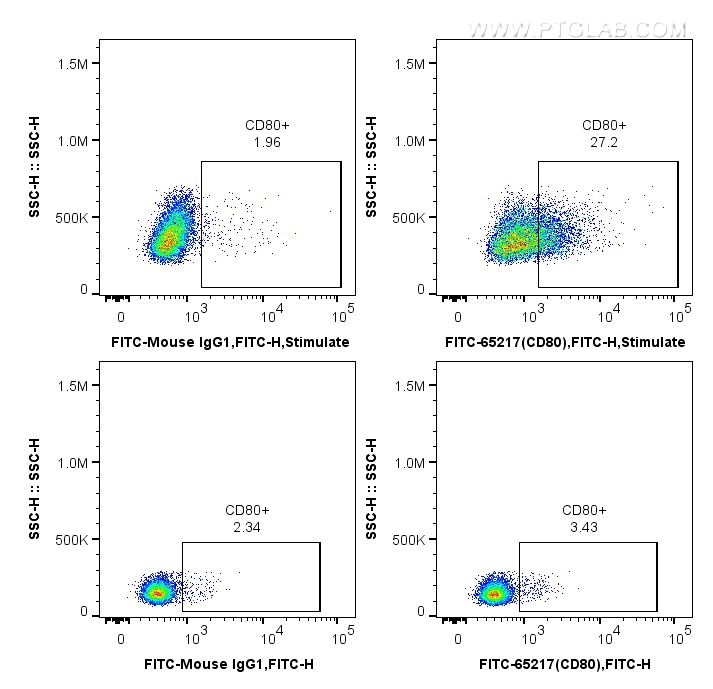验证数据展示
经过测试的应用
| Positive FC detected in | LPS-stimulated Wistar rat splenocytes |
推荐稀释比
| 应用 | 推荐稀释比 |
|---|---|
| This reagent has been tested for flow cytometric analysis. It is recommended that this reagent should be titrated in each testing system to obtain optimal results. | |
| Sample-dependent, Check data in validation data gallery. | |
产品信息
FITC-65217 targets CD80 in FC applications and shows reactivity with rat samples.
| 经测试应用 | FC Application Description |
| 经测试反应性 | rat |
| 免疫原 | HTLV-1-transformed Lewis-S1 rat T cell line 种属同源性预测 |
| 宿主/亚型 | Mouse / IgG1, kappa |
| 抗体类别 | Monoclonal |
| 产品类型 | Antibody |
| 全称 | Cd80 molecule |
| 别名 | Cd80 molecule, B7-1, B7.1, B7 1, 3H5 |
| 计算分子量 | 36 kDa |
| GenBank蛋白编号 | XM_017597885 |
| 基因名称 | CD80 |
| Gene ID (NCBI) | 25408 |
| RRID | AB_2924138 |
| 偶联类型 | FITC Plus Fluorescent Dye |
| 最大激发/发射波长 | 495 nm / 524 nm |
| 形式 | Liquid |
| 纯化方式 | Affinity purification |
| UNIPROT ID | G3V671 |
| 储存缓冲液 | PBS with 0.09% sodium azide , pH 7.3 |
| 储存条件 | Store at 2-8°C. Avoid exposure to light. Stable for one year after shipment. |
背景介绍
CD80 (also known as B7-1) is a type I membrane protein that is a member of the immunoglobulin superfamily, with an extracellular immunoglobulin constant-like domain and a variable-like domain required for receptor binding. It is expressed on antigen-presenting cells (APCs), including B cells, dendritic cells, monocytes, and macrophages. CD80 is the receptor for the proteins CD28 and CTLA-4 found on the surface of T-cells. It is involved in the costimulatory signal essential for T-lymphocyte activation. T-cell proliferation and cytokine production is induced by the binding of CD28, binding to CTLA-4 has opposite effects and inhibits T-cell activation. CD80 also acts as a cellular attachment receptor for adenovirus subgroup B. (PMID: 7545666; 12015893; 16920215)
实验方案
| Product Specific Protocols | |
|---|---|
| FC protocol for FITC Plus CD80 antibody FITC-65217 | Download protocol |
| Standard Protocols | |
|---|---|
| Click here to view our Standard Protocols |

